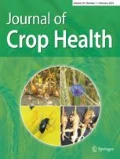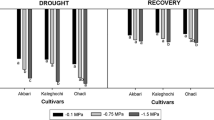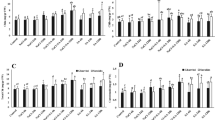Abstract
Pistachio (Pistacia vera L.) is an economically important nut crop that is prone to drought stress since it is mainly produced in arid and semi-arid regions. Considering the possible impact of salicylic acid (SA) on drought tolerance of pistachio, several physiological and biochemical responses of pistachio seedlings to foliar application of SA under progressive drought treatment were investigated. Application of SA increased the content of pigments, chlorophyll, and carotenoids, and improved the accumulation of osmolytes such as proline and total soluble carbohydrates leading to preserve photosynthetic apparatus and relative water content. Moreover, SA application reduced the drought-induced levels of H2O2 and lipid peroxidation in pistachio seedlings by increasing the activity of antioxidant enzymes. According to our findings, ascorbate peroxidase and glutathione reductase play a major role in the antioxidative salicylic acid-induced defense against oxidative stress in pistachio. Taken together, our results show that the foliar application of SA could significantly enhance drought tolerance of pistachio seedlings through protecting photosynthetic apparatus, improving osmoregulation, and inducing the antioxidant defense system.
Zusammenfassung
Die Pistazie (Pistacia vera L.) ist eine wirtschaftlich wichtige Nusspflanze, die anfällig für Trockenstress ist, da sie hauptsächlich in ariden und semi-ariden Regionen angebaut wird. Unter Berücksichtigung des möglichen Einflusses von Salicylsäure (SA) auf die Trockenheitstoleranz von Pistazien wurden verschiedene physiologische und biochemische Reaktionen von Pistaziensämlingen auf die Blattapplikation von SA unter fortschreitendem Trockenstress untersucht. Die Anwendung von SA erhöhte den Gehalt an Pigmenten, Chlorophyll und Carotinoiden und verbesserte die Anreicherung von Osmolyten wie Prolin und den Gesamtgehalt löslicher Kohlenhydrate, was zur Erhaltung des Photosyntheseapparats und des relativen Wassergehalts führte. Darüber hinaus reduzierte die Anwendung von SA die durch Trockenheit induzierte Menge an H2O2 und die Lipidperoxidation in Pistaziensämlingen, indem die Aktivität von antioxidativen Enzymen erhöht wurde. Unsere Untersuchungen haben gezeigt, dass Ascorbatperoxidase und Glutathionreduktase eine wichtige Rolle bei der durch antioxidative Salicylsäure induzierten Abwehr gegen oxidativen Stress bei Pistazien spielen. Zusammengefasst zeigen unsere Ergebnisse, dass die Blattapplikation von SA die Trockenheitstoleranz von Pistaziensämlingen durch den Schutz des Photosyntheseapparats, die Verbesserung der Osmoregulation und die Induktion des antioxidativen Abwehrsystems signifikant verbessern kann.



Similar content being viewed by others
References
Aebi H (1984) Catalase in vitro. In: Oxygen radicals in biological systems. Methods in enzymology, vol 105. Elsevier, Amsterdam, pp 121–126
Agarwal S, Sairam RK, Srivastava GC, Meena RC (2005) Changes in antioxidant enzymes activity and oxidative stress by abscisic acid and salicylic acid in wheat genotypes. Biol plant 49:541–550. https://doi.org/10.1007/s10535-005-0048-z
Ainsworth EA, Gillespie KM (2007) Estimation of total phenolic content and other oxidation substrates in plant tissues using Folin-Ciocalteu reagent. Nat Protoc 2:875–877. https://doi.org/10.1038/nprot.2007.102
Alla MMN, Badawi AHM, Hassan NM et al (2007) Induction of glutathione and glutathione-associated enzymes in butachlor-tolerant plant species. Am J Plant Physiol 2:195–205
Arnon DT (1949) Copper enzyme in isolated chloroplasts polyphenoloxidase in Beta vulgaris. Plant Physiol 24:1–15. https://doi.org/10.1104/pp.24.1.1
Arunyanark A, Jogloy S, Akkasaeng C et al (2008) Chlorophyll stability is an indicator of drought tolerance in peanut. J Agron Crop Sci 194:113–125. https://doi.org/10.1111/j.1439-037X.2008.00299.x
Askari E, Ehsanzadeh P (2015) Drought stress mitigation by foliar application of salicylic acid and their interactive effects on physiological characteristics of fennel (Foeniculum vulgare Mill.) genotypes. Acta Physiol Plant. https://doi.org/10.1007/s11738-014-1762-y
Bandurska H (2013) Salicylic acid: an update on biosynthesis and action in plant response to water deficit and performance under drought. In: Hayat S, Ahmad A, Alyemeni MN (eds) Salicylic acid. Springer, Dordrecht, pp 1–14
Bastam N, Baninasab B, Ghobadi C (2013) Improving salt tolerance by exogenous application of salicylic acid in seedlings of pistachio. Plant Growth Regul 69:275–284. https://doi.org/10.1007/s10725-012-9770-7
Bates LS, Waldren RP, Teare ID (1973) Rapid determination of free proline for water-stress studies. Plant Soil 39:205–207
Beauchamp C, Fridovich I (1971) Superoxide dismutase: improved assays and an assay applicable to acrylamide gels. Anal Biochem 44:276–287. https://doi.org/10.1016/0003-2697(71)90370-8
Beck DJ, Bibby BG (1961) A modified anthrone colorimetric technique for use in investigations related to the cariogenicity of foodstuffs. J Dent Res 40:161–170. https://doi.org/10.1177/00220345610400010801
Black CA, Evans DD, White JL et al (1965) Methods of soil analysis, part (1) and part (2). Am Soc Agron Inc, Publ Madison, Wisconsin
Bradford MM (1976) A rapid and sensitive method for the quantitation of microgram quantities of protein utilizing the principle of protein-dye binding. Anal Biochem 72:248–254
Briens M, Larher F (1982) Osmoregulation in halophytic higher plants: a comparative study of soluble carbohydrates, polyols, betaines and free proline. Plant Cell Environ 5:287–292. https://doi.org/10.1111/1365-3040.ep11572682
Brito C, Dinis LT, Ferreira H et al (2019) Salicylic acid increases drought adaptability of young olive trees by changes on redox status and ionome. Plant Physiol Biochem 141:315–324. https://doi.org/10.1016/j.plaphy.2019.06.011
De Carvalho K, De Campos MKF, Domingues DS, Pereira LFP, Vieira LGE (2013). The accumulation of endogenous proline induces changes in gene expression of several antioxidant enzymes in leaves of transgenic Swingle citrumelo. Mol Biol Rep 40:3269–3279. https://doi.org/10.1007/s11033-012-2402-5
Couée I, Sulmon C, Gouesbet G, El Amrani A (2006) Involvement of soluble sugars in reactive oxygen species balance and responses to oxidative stress in plants. J Exp Bot 57:449–459. https://doi.org/10.1093/jxb/erj027
Cruz De Carvalho MH (2008) Drought stress and reactive oxygen species: production, scavenging and signaling. Plant Signal Behav 3:156–165
Das K, Roychoudhury A (2014) Reactive oxygen species (ROS) and response of antioxidants as ROS-scavengers during environmental stress in plants. Front Environ Sci 2:1–13. https://doi.org/10.3389/fenvs.2014.00053
De Azevedo Neto AD, Prisco JT, Enéas-Filho J et al (2006) Effect of salt stress on antioxidative enzymes and lipid peroxidation in leaves and roots of salt-tolerant and salt-sensitive maize genotypes. Environ Exp Bot 56:87–94. https://doi.org/10.1016/j.envexpbot.2005.01.008
Dutra WF, de Melo AS, Suassuna JF et al (2017) Antioxidative responses of cowpea cultivars to water deficit and salicylic acid treatment. Agron J 109:895–905. https://doi.org/10.2134/agronj2015.0519
Edwards R, Dixon DP, Walbot V (2000) Plant glutathione S‑transferases: enzymes with multiple functions in sickness and in health. Trends Plant Sci 5:193–198
FAOSTAT (2021) Top 10 producers of pistachios. http://www.fao.org/faostat/en/#data/QC/visualize. Accessed 10 June 2021
Fodor J, Gullner G, Ádám AL et al (1997) Local and systemic responses of antioxidants to tobacco mosaic virus infection and to salicylic acid in tobacco: role in systemic acquired resistance. Plant Physiol 114:1443–1451. https://doi.org/10.1104/pp.114.4.1443
Foyer CH, Noctor G (2011) Ascorbate and glutathione: the heart of the redox hub. Plant Physiol 155:2–18
Foyer CH, Deascouveries P, Kunert KJ et al (1994) Protection against oxygen radicals: an important defence mechanism studied in transgenic plants. Plant Cell Environ 17:507–523. https://doi.org/10.1111/j.1365-3040.1994.tb00146.x
Franks PJ, Drake PL, Froend RH (2007) Anisohydric but isohydrodynamic: seasonally constant plant water potential gradient explained by a stomatal control mechanism incorporating variable plant hydraulic conductance. Plant Cell Environ 30:19–30. https://doi.org/10.1111/j.1365-3040.2006.01600.x
Ghamari M, Hosseininaveh V, Talebi K et al (2020) Biochemical characterization of the induced immune system of pistachio (Pistacia vera) by salicylic acid. Int J Fruit Sci 20:117–132. https://doi.org/10.1080/15538362.2019.1586025
Gill SS, Tuteja N (2010) Reactive oxygen species and antioxidant machinery in abiotic stress tolerance in crop plants. Plant Physiol Biochem 48:909–930
Goldhamer DA (1995) Irrigation management. In: Ferguson L (eds) Pistachio Production Manual. Fruit and Nut Research and Information Center. University of California, Davis, CA, USA, pp 71–81
Gullner G, Komives T, Király L, Schröder P (2018) Glutathione S‑transferase enzymes in plant-pathogen interactions. Front Plant Sci. https://doi.org/10.3389/fpls.2018.01836
Hasanuzzaman M, Hossain MA, Teixeira JA et al (2012) Plant response and tolerance to abiotic oxidative stress: antioxidant defense is a key factor. In: Venkateswarlu B, Shanker AK, Shanker C, Maheswari M (eds) Crop stress and its management: perspectives and strategies. Springer, Dordrecht, pp 261–315
Hayat Q, Hayat S, Irfan M, Ahmad A (2010) Effect of exogenous salicylic acid under changing environment: a review. Environ Exp Bot 68:14–25. https://doi.org/10.1016/j.envexpbot.2009.08.005
Hayat S, Hayat Q, Alyemeni MN et al (2012) Role of proline under changing environments: a review. Plant Signal Behav 7:1456–1466
Hayat S, Hasan SA, Fariduddin Q, Ahmad A (2008) Growth of tomato (Lycopersicon esculentum) in response to salicylic acid under water stress. J Plant Interact 3:297–304. https://doi.org/10.1080/17429140802320797
Hodaei M, Rahimmalek M, Arzani A, Talebi M (2018) The effect of water stress on phytochemical accumulation, bioactive compounds and expression of key genes involved in flavonoid biosynthesis in Chrysanthemum morifolium L. Ind Crops Prod 120:295–304. https://doi.org/10.1016/j.indcrop.2018.04.073
Hossain MA, Bhattacharjee S, Armin SM et al (2015) Hydrogen peroxide priming modulates abiotic oxidative stress tolerance: insights from ROS detoxification and scavenging. Front Plant Sci 6:1–19. https://doi.org/10.3389/fpls.2015.00420
Hou J, Huang X, Sun W et al (2018) Accumulation of water-soluble carbohydrates and gene expression in wheat stems correlates with drought resistance. J Plant Physiol 231:182–191. https://doi.org/10.1016/j.jplph.2018.09.017
Huang J, Gu M, Lai Z et al (2010) Functional analysis of the Arabidopsis PAL gene family in plant growth, development, and response to environmental stress. Plant Physiol 153:1526–1538. https://doi.org/10.1104/pp.110.157370
Jesus C, Meijón M, Monteiro P et al (2015) Salicylic acid application modulates physiological and hormonal changes in Eucalyptus globulus under water deficit. Environ Exp Bot 118:56–66. https://doi.org/10.1016/j.envexpbot.2015.06.004
Kadioglu A, Saruhan N, Sağlam A et al (2011) Exogenous Salicylic acid alleviates effects of long term drought stress and delays leaf rolling by inducing antioxidant system. Plant Growth Regul 64:27–37. https://doi.org/10.1007/s10725-010-9532-3
Kamali A, Owji A (2016) Agro-ecological requirements for growing pistachio trees: a literature review. Elixir Agric 96:41450–41454
Kanber R, Yazar A, Önder S, Köksal H (1993) Irrigation response of Pistachio (Pistacia vera L.). Irrig Sci 14:7–14. https://doi.org/10.1007/BF00195000
Kang GZ, Li GZ, Liu GQ et al (2013) Exogenous salicylic acid enhances wheat drought tolerance by influence on the expression of genes related to ascorbate-glutathione cycle. Biol plant 57:718–724. https://doi.org/10.1007/s10535-013-0335-z
Karimi S, Rahemi M, Maftoun M et al (2009) Effects of long-term salinity on growth and performance of two pistachio (Pistacia L.) rootstocks. Aust J Basic Appl Sci 3:1630–1639
Khan MIR, Fatma M, Per TS et al (2015) Salicylic acid-induced abiotic stress tolerance and underlying mechanisms in plants. Front Plant Sci 6:1–17. https://doi.org/10.3389/fpls.2015.00462
Khoyerdi FF, Shamshiri MH, Estaji A (2016) Changes in some physiological and osmotic parameters of several pistachio genotypes under drought stress. Sci Hortic 198:44–51. https://doi.org/10.1016/j.scienta.2015.11.028
Klessig DF, Durner J, Noad R et al (2000) Nitric oxide and salicylic acid signaling in plant defense. Proc Natl Acad Sci U S A 97:8849–8855. https://doi.org/10.1073/pnas.97.16.8849
Kulbat K (2016) Biotechnology and food sciences the role of phenolic compounds in plant resistance. Biotechnol Food Sci 80:97–108
La VH, Lee BR, Zhang Q et al (2019) Salicylic acid improves drought-stress tolerance by regulating the redox status and proline metabolism in Brassica rapa. Hortic Environ Biotechnol 60:31–40. https://doi.org/10.1007/s13580-018-0099-7
Larkindale J, Huang B (2004) Thermotolerance and antioxidant systems in Agrostis stolonifera: involvement of salicylic acid, abscisic acid, calcium, hydrogen peroxide, and ethylene. J Plant Physiol 161:405–413. https://doi.org/10.1078/0176-1617-01239
Laxa M, Liebthal M, Telman W et al (2019) The Role of the Plant Antioxidant System in Drought Tolerance. Antioxidants 8:94. https://doi.org/10.3390/antiox8040094
Nakano Y, Asada K (1981) Hydrogen peroxide is scavenged by ascorbate-specific peroxidase in spinach chloroplasts. Plant Cell Physiol 22:867–880. https://doi.org/10.1093/oxfordjournals.pcp.a076232
Pakzad R, Fatehi F, Kalantar M, Maleki M (2019) Evaluating the antioxidant enzymes activities, lipid peroxidation and proteomic profile changing in UCB-1 pistachio rootstock leaf under drought stress. Sci Hortic 256. https://doi.org/10.1016/j.scienta.2019.108617
Panahirad S, Zaare-Nahandi F, Mohammadi N et al (2014) Effects of salicylic acid on aspergillus flavus infection and aflatoxin B1 accumulation in pistachio (Pistacia vera L.) fruit. J Sci Food Agric 94:1758–1763. https://doi.org/10.1002/jsfa.6488
Razmi N, Ebadi A, Daneshian J, Jahanbakhsh S (2017) Salicylic acid induced changes on antioxidant capacity, pigments and grain yield of soybean genotypes in water deficit condition. J Plant Interact 12:457–464. https://doi.org/10.1080/17429145.2017.1392623
Rezayian M, Niknam V, Ebrahimzadeh H (2018) Differential responses of phenolic compounds of Brassica napus under drought stress. Iran J Plant Physiol 8:2417–2425. https://doi.org/10.22034/ijpp.2018.540887
Sakihama Y, Cohen MF, Grace SC, Yamasaki H (2002) Plant phenolic antioxidant and prooxidant activities: phenolics-induced oxidative damage mediated by metals in plants. Toxicology 177:67–80. https://doi.org/10.1016/S0300-483X(02)00196-8
Salehi-lisar SY, Bakhshayeshan-Agdam H (2016) Drought stress in plants: causes, consequences, and tolerance. In: Drought stress tolerance in plants, vol 1. Springer, Cham, pp 1–16
Sappl PG, Carroll AJ, Clifton R et al (2009) The Arabidopsis glutathione transferase gene family displays complex stress regulation and co-silencing multiple genes results in altered metabolic sensitivity to oxidative stress. Plant J 58:53–68. https://doi.org/10.1111/j.1365-313X.2008.03761.x
Sappl PG, Oñate-Sánchez L, Singh KB, Millar AH (2004) Proteomic analysis of glutathione S‑transferases of Arabidopsis thaliana reveals differential salicylic acid-induced expression of the plant-specific phi and tau classes. Plant Mol Biol 54:205–219. https://doi.org/10.1023/B:PLAN.0000028786.57439.b3
Saruhan N, Saglam A, Kadioglu A (2012) Salicylic acid pretreatment induces drought tolerance and delays leaf rolling by inducing antioxidant systems in maize genotypes. Acta Physiol Plant 34:97–106. https://doi.org/10.1007/s11738-011-0808-7
Sedaghat M, Tahmasebi-Sarvestani Z, Emam Y, Mokhtassi-Bidgoli A (2017) Physiological and antioxidant responses of winter wheat cultivars to strigolactone and salicylic acid in drought. Plant Physiol Biochem 119:59–69. https://doi.org/10.1016/j.plaphy.2017.08.015
Shahabinejad M, Shojaaddini M, Maserti B et al (2014) Exogenous application of methyl jasmonate and salicylic acid increases antioxidant activity in the leaves of pistachio (Pistacia vera L. cv. Fandoughi) trees and reduces the performance of the phloem-feeding psyllid Agonoscena pistaciae. Arthropod Plant Interact 8:525–530. https://doi.org/10.1007/s11829-014-9334-z
Sharma A, Shahzad B, Rehman A et al (2019) Response of phenylpropanoid pathway and the role of polyphenols in plants under abiotic stress. Molecules 24:1–22
Sharma M, Gupta SK, Majumder B et al (2017) Salicylic acid mediated growth, physiological and proteomic responses in two wheat varieties under drought stress. J Proteomics 163:28–51. https://doi.org/10.1016/j.jprot.2017.05.011
Signorelli S, Arellano JB, Melø TB, Borsani O, Monza J (2013) Proline does not quench singlet oxygen: Evidence to reconsider its protective role in plants. Plant Physiol Biochem 64:80–83. https://doi.org/10.1016/j.plaphy.2012.12.017
Silva FLB, Vieira LGE, Ribas AF et al (2018) Proline accumulation induces the production of total phenolics in transgenic tobacco plants under water deficit without increasing the G6PDH activity. Theor Exp Plant Physiol 30:251–260. https://doi.org/10.1007/s40626-018-0119-0
Singh B, Usha K (2003) Salicylic acid induced physiological and biochemical changes in wheat seedlings under water stress. Plant Growth Regul 39:137–141. https://doi.org/10.1023/A:1022556103536
Smith IK, Vierheller TL, Thorne CA (1988) Assay of glutathione reductase in crude tissue homogenates using 5,5′-dithiobis(2-nitrobenzoic acid). Anal Biochem 175:408–413. https://doi.org/10.1016/0003-2697(88)90564-7
Sunkar R, Kapoor A, Zhu J‑K (2006) Posttranscriptional induction of two Cu/Zn superoxide dismutase genes in Arabidopsis is mediated by downregulation of miR398 and important for oxidative stress tolerance. Plant Cell 18:2051–2065. https://doi.org/10.1105/tpc.106.041673.1
Tang Y, Sun X, Wen T et al (2017) Implications of terminal oxidase function in regulation of salicylic acid on soybean seedling photosynthetic performance under water stress. Plant Physiol Biochem 112:19–28. https://doi.org/10.1016/j.plaphy.2016.11.016
Torun H (2019) Time-course analysis of salicylic acid effects on ROS regulation and antioxidant defense in roots of hulled and hulless barley under combined stress of drought, heat and salinity. Physiol Plant 165:169–182. https://doi.org/10.1111/ppl.12798
Turner NC, City C (1981) Techniques and experimental approaches for the measurement of plant water status. Plant Soil 58:339–366
Velikova V, Yordanov I, Edreva A (2000) Oxidative stress and some antioxidant systems in acid rain-treated bean plants protective role of exogenous polyamines. Plant Sci 151:59–66. https://doi.org/10.1016/S0168-9452(99)00197-1
Wang JW, Zheng LP, Wu JY, Tan RX (2006) Involvement of nitric oxide in oxidative burst, phenylalanine ammonia-lyase activation and Taxol production induced by low-energy ultrasound in Taxus yunnanensis cell suspension cultures. Nitric Oxide 15:351–358. https://doi.org/10.1016/j.niox.2006.04.261
Acknowledgements
This research was supported by the research and technology deputy of the University of Tehran. The authors would like to thank Dr. Richard Morton (Department of Biology, McMaster University) for the critical reading of this manuscript.
Author information
Authors and Affiliations
Corresponding author
Ethics declarations
Conflict of interest
S. Reyhani Haghighi, V. Hosseininaveh, R. Maali-Amiri, K. Talebi and S. Irani declare that they have no competing interests.
Supplementary Information
10343_2021_569_MOESM1_ESM.pdf
Figure S1. Experimental design and implementation of treatments. Figure S2. Three independent biological experiments replicate at different dates in three replicates. Figure S3. Graph of midday leaf water potential data.
Rights and permissions
About this article
Cite this article
Reyhani Haghighi, S., Hosseininaveh, V., Maali-Amiri, R. et al. Improving the Drought Tolerance in Pistachio (Pistacia vera) Seedlings by Foliar Application of Salicylic Acid. Gesunde Pflanzen 73, 495–507 (2021). https://doi.org/10.1007/s10343-021-00569-z
Received:
Accepted:
Published:
Issue Date:
DOI: https://doi.org/10.1007/s10343-021-00569-z




